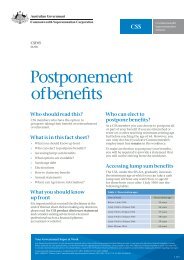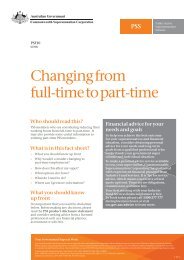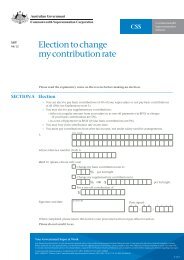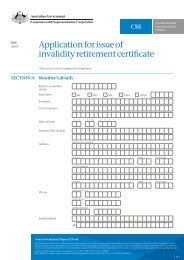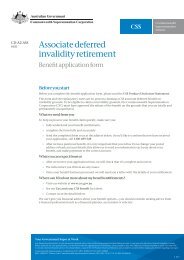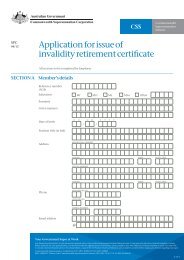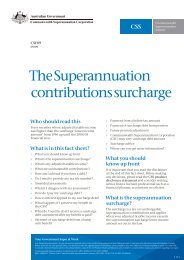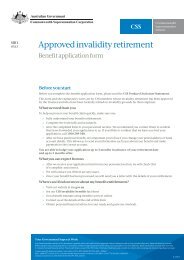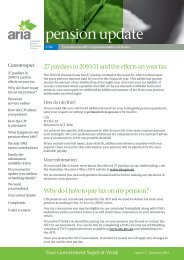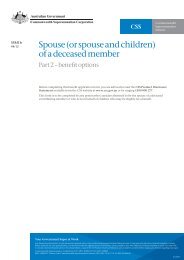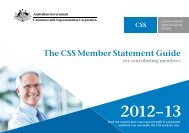CSS 2007-2008 Annual Report to Contributing Members
CSS 2007-2008 Annual Report to Contributing Members
CSS 2007-2008 Annual Report to Contributing Members
You also want an ePaper? Increase the reach of your titles
YUMPU automatically turns print PDFs into web optimized ePapers that Google loves.
Welcome 2Planning for life after work 4Be prepared 5Adapt your super strategy <strong>to</strong> your lifestage 9Make your super work for you 18Member Statement Guide 26Your super details 27Your resignation benefit 29Your age retirement benefit 31Your death and invalidity cover 32Other important information 37Superannuation surcharge 40Things you should know 41<strong>CSS</strong> contents<strong>Report</strong> for the year 42Chairman’s report 42News 44<strong>CSS</strong> investments 47Financial statements 55Your trustees for <strong>2007</strong>/08 56Feedback 57Contact us 58Contents1 | <strong>CSS</strong>
Planningfor lifeafter workThis section outlines what supermight mean <strong>to</strong> you at differentages and stages of your life. It offerssome important tips about how <strong>to</strong>Be prepared, Adapt yoursuper strategy <strong>to</strong> yourlifestage and Make yoursuper work for you.Be preparedWe all want <strong>to</strong> be financially comfortableonce we’re no longer working, andknowing when <strong>to</strong> think about your superis an important step in ensuring you haveadequate funds in place <strong>to</strong> be able <strong>to</strong> enjoyyour life after work. Everyone’s livingexpenses and financial goals are different,and you need <strong>to</strong> consider how you’ll achieveyour desired lifestyle once you retire.We’ve given you a head start by providingsome super strategies for different stagesof your life. We’ve also created a lifestagessection at www.css.gov.au that may giveyou some fresh ideas.The main steps involve deciding how muchmoney you think you’ll need once you’ves<strong>to</strong>pped work, working out what cash flowyou’re likely <strong>to</strong> have, calculating what cashflow you’re likely <strong>to</strong> need and thinkingabout how <strong>to</strong> supplement your savings.1. Work out how much money you’re likely <strong>to</strong> needMost of us have an idea of when we want<strong>to</strong> s<strong>to</strong>p working but we might not knowhow much money we’re going <strong>to</strong> need <strong>to</strong>enjoy that phase of our lives. There’s no‘one size fits all’ answer, but theWestpac-ASFA Retirement Living StandardResearch (available atwww.superannuation.asn.au)gives you an indication of how much youmight need. Doing a budget is a great way<strong>to</strong> estimate this, especially if you cancompare your budget now with what youthink you’ll need for your life after work.You’ll find a good budget template atwww.understandingmoney.gov.aubut remember that your needs may varydepending on your lifestage and lifestyle.To paint a more accurate personal picture,ask yourself:>>When do I want <strong>to</strong> retire?>> Where do I want <strong>to</strong> live onceI’m no longer working?>> If I retire at that time, how long will mysavings need <strong>to</strong> last? Consider that theaverage life expectancy for a man is78 years and for a woman is 83 years.<strong>CSS</strong> planning for life after work>>>>>>Will I still have debts <strong>to</strong> cover?What sort of lifestyle do I want?How much will that lifestyle cost?4 | <strong>CSS</strong>5 | <strong>CSS</strong>
2. Calculate what cash flow you’re likely <strong>to</strong> haveThe next step in putting <strong>to</strong>gether a plan is<strong>to</strong> get an idea of the income from super andother sources that you’re likely <strong>to</strong> have afteryou s<strong>to</strong>p working. You can:> > use the <strong>CSS</strong> i-Estima<strong>to</strong>r via <strong>Members</strong>ervices online at www.css.gov.au>> consider any other ways you may beable <strong>to</strong> supplement your super, such asinvesting in shares or property.3. Have a look at ways you cansupplement your savingsIf there’s a big difference between howmuch money you think you’re going <strong>to</strong>need and how much you’re likely <strong>to</strong> have,there’s no need <strong>to</strong> panic. There are a numberof different things you can do <strong>to</strong> supplementyour savings, <strong>to</strong> help you bridge the gap.Have a look at:>>your contribution options (see page 18)>> different ways you can <strong>to</strong>p-up your superwith your own money (see page 19)Start your journey with the destination in sightWhen it comes <strong>to</strong> super, it pays <strong>to</strong> bedisciplined throughout your working liferather than sprinting at the end of yourworking journey. If you make regularcontributions <strong>to</strong> your super from thebeginning, and <strong>to</strong>p these up wheneveryou can, you will likely be much better offthan if you try and get yourself over the linein the last few years of your working life.<strong>CSS</strong> planning for life after work>>different options for claiming your super.You don’t have <strong>to</strong> take it all at once —you can keep it invested so it continues<strong>to</strong> grow (go <strong>to</strong> www.fido.gov.au foruseful information about yourdifferent options)>> the tax and social security implicationsof your different choices — theCentrelink planning forretirement service is a useful onlineguide <strong>to</strong> payments, services, programs,publications and forms relating <strong>to</strong>life after work. You can access it viawww.css.gov.au in the 55+ lifestage area.6 | <strong>CSS</strong>7 | <strong>CSS</strong>
Adapt your superstrategy <strong>to</strong> your lifestage<strong>CSS</strong> planning for life after workThere are lots of steps you can take <strong>to</strong> make the most ofyour super journey. We’re keen <strong>to</strong> make sure you havethe information you need <strong>to</strong> make important decisionsabout your super. Depending on your lifestage, you maywant <strong>to</strong> plan, prepare, step-up or arrive.8 | <strong>CSS</strong>9 | <strong>CSS</strong>
PlanTake thefirst step onyour superjourney.Help your family<strong>to</strong> planWe teach our kids many essential life skills.But can we help them become financiallyresponsible and ultimately independent?As every parent knows, kids learn as muchfrom what we do as from what we say.Set a good exampleAs a first step, try <strong>to</strong> make sure you lead byexample with your money managementpractices. Also, think about:>> establishing jobs (outside ofhousehold chores) that can earnthem pocket money>> encouraging them <strong>to</strong> set money asidefrom their pocket money <strong>to</strong> save forsomething they really want>> setting up a bank or credit unionaccount for them so they can watchtheir savings grow over time, and learnabout interest>> for teenagers, starting <strong>to</strong> pay pocketmoney fortnightly or even monthly sothey learn how <strong>to</strong> budget.Introduce your kids <strong>to</strong> superIf your kids are working, and will earnless than $58,980 in <strong>2007</strong>/08 ($60,342 in<strong>2008</strong>/09), they’re probably eligible for thesuper co-contribution. Encourage them <strong>to</strong>put $1 of their own money in<strong>to</strong> super andthen the government may put in as muchas another $1.50* (up <strong>to</strong> a maximum of$1,500 per year). It’s as easy as making a bankdeposit — see page 22 for more information.Another important point <strong>to</strong> make with yourkids once they start investing in super isthat they need <strong>to</strong> keep track of their superespecially when they change jobs. It makesthings much simpler if they roll their superin<strong>to</strong> one account and it can also make a bigdifference <strong>to</strong> how much money they’ll haveby the time they want <strong>to</strong> claim their super.Take the next stepFor more handy financial information foryour family, go <strong>to</strong> the lifestage section atwww.css.gov.au* Subject <strong>to</strong> eligibility requirementsand caps — see page 22 for full details.<strong>CSS</strong> planning for life after work10 | <strong>CSS</strong>11 | <strong>CSS</strong>
26–44 45–55 55+Stay focusedon whereyou’reheading.Are you aged 26-44?The next stepis <strong>to</strong> prepareAre you finding it hard <strong>to</strong> makesuperannuation a priority among all yourother commitments <strong>to</strong> your job, relationshipor family? You’re not alone.You’ve started out on your super journey, butnow is a good time <strong>to</strong> make sure it’s workingfor you and taking you where you want <strong>to</strong>go. At this stage of your life, you need <strong>to</strong> startpreparing for your life after work even asyou’re climbing the corporate ladder.Here are some tips <strong>to</strong> help you take the nextstep on your super journey:>> Check your eligibility for superco-contributions. For every dollaryou put in<strong>to</strong> your super, the AustralianGovernment will contribute up <strong>to</strong>$1.50* (<strong>to</strong> a maximum of $1,500), whichcan make a huge difference <strong>to</strong> yourfinal super figure by the time you s<strong>to</strong>pworking. The super co-contributionamount reduces by five cents for every$1,000 you earned over $28,980 in<strong>2007</strong>/08 ($30,342 in <strong>2008</strong>/09) (see page 22for more information).>> Start thinking about when you want <strong>to</strong> retire so you can decide onthe best strategy and the most favourableinvestment options for your super in thetimeframe you’ve got (see page 51 formore information).> > Moni<strong>to</strong>r your progress and makesure your super is heading in the rightdirection. To work out how muchmoney you’re likely <strong>to</strong> have by the timeyou s<strong>to</strong>p work, use the <strong>CSS</strong> i-Estima<strong>to</strong>rvia Member services online atwww.css.gov.auTake the next stepFor more about the <strong>CSS</strong> in general — visitwww.css.gov.auFor more information about super strategiesthat are right for your stage of the journey,see our lifestage section at www.css.gov.au* Subject <strong>to</strong> eligibility requirementsand caps — see page 22 for full details.<strong>CSS</strong> planning for life after workPrepare12 | <strong>CSS</strong>13 | <strong>CSS</strong>
26–44 45–55 55+Take the rightroad and stayon track.Step-upAre you aged 45-55?It’s time <strong>to</strong> step-upBy this stage of your life, life after workis becoming much more of a realityand you’re keen <strong>to</strong> make sure you’ll befinancially comfortable once you s<strong>to</strong>pworking. With your career established andmaybe less financial responsibility, you mayhave a larger disposable income. This is thetime <strong>to</strong> review your living expenses and<strong>to</strong>p-up your super savings if you need <strong>to</strong>.>> Start thinking about when youwant <strong>to</strong> retire so you can decideon the best strategy and the mostfavourable investment options for yoursuper in the timeframe you’ve got (seepage 51 for more information).>> Decide how you want <strong>to</strong> claimyour super, whether you can andshould take it as a pension or a lump sumor a combination of both. Check ou<strong>to</strong>ur website and get some advice froma financial adviser <strong>to</strong> make sure you’veconsidered all your options.> > Moni<strong>to</strong>r your progress and makesure your super is heading in the rightdirection. To work out how muchmoney you’re likely <strong>to</strong> have by thetime you s<strong>to</strong>p work, use the <strong>CSS</strong>i-Estima<strong>to</strong>r via Member servicesonline at www.css.gov.au If youdon’t think your current strategy isgoing <strong>to</strong> give you the lifestyle you wan<strong>to</strong>nce you’re no longer working, thinkabout making some changes now.Take the next stepFind out more about the <strong>CSS</strong> in general —visit www.css.gov.auIf you’d like more information about superstrategies that are right for your stage ofthe journey, visit the lifestage section atwww.css.gov.au<strong>CSS</strong> planning for life after work14 | <strong>CSS</strong>15 | <strong>CSS</strong>
Arrive26–44 45–55 55+It’s not only thejourney – it’s thedestination <strong>to</strong>o.Are you aged 55+?Get ready <strong>to</strong> arriveNow you’re nearing the end of yourworking life and getting close <strong>to</strong> beginningyour life after work. That doesn’t meanit’s <strong>to</strong>o late <strong>to</strong> adapt your strategy andinvestment options <strong>to</strong> your timeframe and<strong>to</strong>p-up your super if you need <strong>to</strong>. Also, youneed <strong>to</strong> think about the best way <strong>to</strong> claimyour super so you can continue <strong>to</strong> live inthe way you’re used <strong>to</strong>.>> Start thinking about when youwant <strong>to</strong> retire so you can decideon the best strategy and the mostfavourable investment options for yoursuper in the timeframe you’ve got (seepage 51 for more information).>> Think about making additionalcontributions. You might have moredisposable income right now and addingit <strong>to</strong> your super will give it an extra boost(see page 19 for more information).>> Take a look at how your super isinvested and decide whether you want<strong>to</strong> opt for the Cash Investment Option(giving you greater surety of earningsfor your member and productivitycomponents) or the Default Fund (whichwill yield a possibly higher but morevolatile return) (see page 51 for moreinformation).>> Decide how you want <strong>to</strong> claimyour super, whether you can andshould take it as a pension or a lumpsum, or a combination of both. Checkout our website and get some advicefrom a financial adviser <strong>to</strong> make sureyou’ve considered all your options.Take the next stepFor more about the <strong>CSS</strong> in general — visitwww.css.gov.au<strong>CSS</strong> planning for life after workIf you’d like more information about superstrategies that are right for your stage ofthe journey, see our lifestage section atwww.css.gov.au16 | <strong>CSS</strong>17 | <strong>CSS</strong>
Make yoursuper workfor youTo make the most of yoursuper journey, you need<strong>to</strong> stay informed andcheck regularly whetheryour super is taking youwhere you want <strong>to</strong> go.How your contributions affect your final benefitYour <strong>CSS</strong> benefit consists of:>> your basic contributions — the after taxcontributions you pay each fortnight(plus Fund earnings). You can choose <strong>to</strong>contribute 5% or nothing at all (0%)>> your supplementary contributions —any additional after tax contributionsyou make on <strong>to</strong>p of your basiccontribution (plus Fund earnings)>> a productivity benefit ‚— a fortnightlycontribution by your employer (plusFund earnings)>> an employer-financed component —a defined amount financed by youremployer, which you receive as aConsumer Priced Index (CPI)-indexedpension when you leave the workforce>> any amounts you’ve transferred fromother super funds (plus Fund earnings)>> any super co-contributions(plus Fund earnings).Decide how much super you want <strong>to</strong> contributeIf you’re a <strong>CSS</strong> contributing member, oneof the most important choices you have <strong>to</strong>make is the rate at which you’re going <strong>to</strong>contribute. For many people, this mostlyaffects the accumulation part of their super,but for some members it will also affectthe pension benefit they’re entitled <strong>to</strong>.Before you decide <strong>to</strong> s<strong>to</strong>p contributing, youshould seek professional advice from anexperienced financial adviser.The following table shows how increasingyour supplementary contributions by aslittle as $20, $40 or $100 a fortnight cangive you a whole lot more super whenyou come <strong>to</strong> claim it. That’s because thatmoney is invested across a range of assetclasses giving you the benefit of diversifiedreturns and compound interest. This tableis an illustration only and should not betaken as a forecast or prediction of anyparticular rate of return. Actual returnsmay differ materially from the figuresused in this illustration.Your supplementaryfortnightly contributionInvestment period10 years 25 years 40 Years$20.00 $6,560 $24,000 $58,240$40.00 $13,120 $48,010 $116,490$100.00 $32,800 $120,020 $291,210Please note: Calculations assume that the extra fortnightly contribution is made continuously throughoutthe investment period and real investment return of 4.5% (CPI + 4.5%) is achieved on the assumption CPIremains at 2.5%. This rate is assumed for the purpose of this illustration only and ARIA does not representthat this return will be achieved.You can change your contribution rateat any time by completing an Election <strong>to</strong> vary superannuation contributionrate form, available from www.css.gov.auTo find out more about your <strong>CSS</strong> contributions,visit www.css.gov.au, emailmembers@css.gov.au or call us on1300 000 277.Make small extra contributions andmake a huge differenceSuperannuation is one of the mosttax-effective investments available, becauseinvestment earnings are only taxed at15%. Other investments can attract a muchhigher rate of tax, often 31.5% (includinga Medicare levy) or more. When you lookat this over the long-term and consider thecompound interest earned by that extramoney in superannuation year in, year out,you can see exactly why <strong>to</strong>pping up your supercan be a good strategy.There are several ways you can <strong>to</strong>p-up your super:>> You can supplement your super from after-taxdollars; even a couple of hundred dollars everynow and then can make a huge difference <strong>to</strong>your <strong>to</strong>tal benefit.>> You can roll your salary sacrifice contributionsyou make <strong>to</strong> another fund over in<strong>to</strong> your<strong>CSS</strong> account at any time (see page 21 for moreinformation).>> If you earned less than $58,980 during the<strong>2007</strong>/08 financial year ($60,342 for <strong>2008</strong>/09),you may be able <strong>to</strong> take advantage of the superco-contribution and give your savings an addedboost (see page 22 for more information).<strong>CSS</strong> planning for life after work18 | <strong>CSS</strong>19 | <strong>CSS</strong>
How <strong>to</strong> estimate your benefitYou can estimate your retirement benefitat any time by using the <strong>CSS</strong> i-Estima<strong>to</strong>r atwww.css.gov.au To access it, you’ll need<strong>to</strong> log on <strong>to</strong> Member services onlinewith your personal access number. If youdon’t have an access number, you can callus on 1300 000 277 and we can give you anumber over the phone.If you’re retiring in the next 12 months andwant a detailed benefit estimate, call us on1300 000 277. To find out more aboutyour super and how <strong>to</strong> <strong>to</strong>p it up, visitwww.css.gov.au, send an email <strong>to</strong>members@css.gov.au or call us on1300 000 277.Check whether you can receive atransition <strong>to</strong> retirement pensionThe <strong>CSS</strong> transition <strong>to</strong> retirement ruleshaven’t changed. However, there are limitedsituations where upon reaching theirminimum retirement age a <strong>CSS</strong> membercan cease their membership, access theiremployer-financed benefit as a pensionand roll over their lump sum <strong>to</strong> anothersuperannuation scheme.For more information, see theTransition <strong>to</strong> retirement fact sheet atwww.css.gov.au and seek professionalfinancial advice.Consolidate your superIf you’ve had more than one job, you mighthave super invested in more than one fund, andyou may be paying additional fees for keepingthat super separately invested. By consolidatingyour super in<strong>to</strong> one account, you may save onmanagement fees. It will also be a lot easier foryou <strong>to</strong> keep track of your retirement savings, asit’s much easier <strong>to</strong> keep an eye on one accountthan many different ones.You can only transfer super from other fundsin<strong>to</strong> the <strong>CSS</strong> if you’re a contributing member.Transferring is easy — all you need <strong>to</strong> do is write<strong>to</strong> us and let us know that you intend <strong>to</strong> transferyour super <strong>to</strong> us. You’ll also need <strong>to</strong> contact yourother fund(s) and complete their paperwork aswell, <strong>to</strong> enable the rollover of other super in<strong>to</strong>the <strong>CSS</strong>. Once that super is transferred <strong>to</strong> your<strong>CSS</strong> account, we’ll write <strong>to</strong> you <strong>to</strong> confirm thatthe transfer has been completed.If you think you have some ‘lost’ super —that is, you have super in other funds, but you’renot sure which ones — you can trackit down by doing free online searches atwww.unclaimedsuper.com.au orwww.a<strong>to</strong>.gov.au/super using SuperSeeker.<strong>CSS</strong> planning for life after work20 | <strong>CSS</strong>21 | <strong>CSS</strong>
Check whether you’re eligible <strong>to</strong>receive a super co-contributionIf you earned less than $58,980 in <strong>2007</strong>/08($60,342 in <strong>2008</strong>/09), you may be able <strong>to</strong>take advantage of the super co-contribution.If you’re eligible, for every dollar you putin<strong>to</strong> your super after tax, the AustralianGovernment will contribute up <strong>to</strong> $1.50 (<strong>to</strong> amaximum of $1,500). This can make a hugedifference <strong>to</strong> your final super figure by thetime you s<strong>to</strong>p working. The superco-contribution amount reduces by fivecents for every $1,000 you earned over$28,980 in <strong>2007</strong>/08 ($30,342 in <strong>2008</strong>/09).To take advantage of the superco-contribution, you need <strong>to</strong>:>> make a personal, after-tax contribution<strong>to</strong> your super (such as your standard 5%contributions)>> receive 10% or more of your <strong>to</strong>talincome from eligible employment>> not hold an eligible temporary residentvisa at any time during the year>> lodge an income tax return for theincome year>>be less than 71 years old at the end of theOnce you’ve lodged your tax return withthe Australian Taxation Office (ATO), theinformation you’ve provided will be used<strong>to</strong> check your eligibility. The ATO willcalculate the amount of your superco-contribution and then deposit it directlyin<strong>to</strong> your <strong>CSS</strong> super account. You don’tneed <strong>to</strong> do anything — it will happenau<strong>to</strong>matically once you’ve lodged yourtax return.The following table shows how much youcan expect* <strong>to</strong> receive based on your <strong>to</strong>talincome, which is your assessable incomeplus any reportable fringe benefits, and anafter-tax contribution of $1,000, $800, $500or $200.In the year <strong>2008</strong>/09 if your personal superannuation contribution (after-tax) is:And your income is:$1,000 $800 $500 $200Your super co-contribution will be:$30,342 $1,500 $1,200 $750 $300$32,342 $1,400 $1,200 $750 $300$34,342 $1,300 $1,200 $750 $300$36,342 $1,200 $1,200 $750 $300$38,342 $1,100 $1,100 $750 $300$40,342 $1,000 $1,000 $750 $300$42,342 $900 $900 $750 $300$44,342 $800 $800 $750 $300$46,342 $700 $700 $700 $300$48,342 $600 $600 $600 $300$50,342 $500 $500 $500 $300$52,342 $400 $400 $400 $300$54,342 $300 $300 $300 $300$56,342 $200 $200 $200 $200$58,342 $100 $100 $100 $100$60,342 $0 $0 $0 $0<strong>CSS</strong> planning for life after workincome year.* Provided you are eligible, eligibility for the super co-contribution is determined by the Australian TaxationOffice, based on the tax return you submit.To find out more about how the super co-contribution works, visit www.css.gov.au, emailmembers@css.gov.au or call 1300 000 277. Alternatively, check out the ATO’s website atwww.a<strong>to</strong>.gov.au/super where you’ll also find a handy calcula<strong>to</strong>r.22 | <strong>CSS</strong>23 | <strong>CSS</strong>
Get up-<strong>to</strong>-date with the latest changesTwo changes introduced by thegovernment came in<strong>to</strong> effect duringthe year. These were:>> early access <strong>to</strong> benefits for contributingmembers>>changes <strong>to</strong> member contributions.Early access <strong>to</strong> benefits forcontributing membersFrom 1 January <strong>2008</strong> some members maybe able <strong>to</strong> access a part of their <strong>CSS</strong> benefitearly. This is allowed on the grounds ofsevere financial hardship or for otherspecified reasons, or may be grantedunder a determination made bythe Australian Prudential RegulationAuthority (APRA).To access your benefits early for financialhardship reasons, you must meet theeligibility requirements and provide theapplication and relevant documentation<strong>to</strong> us. We’ll assess your application againstthe relevant guidelines and determinehow much of your superannuation will bereleased. The amount released can’t be morethan $10,000 gross, and only one paymentcan be approved in any 12-month period.If you don’t meet the requirements forfinancial hardship, you can apply <strong>to</strong> APRA <strong>to</strong>approve the release of benefits on specifiedgrounds (such as <strong>to</strong> meet the cost of medicalexpenses or mortgage repayments, <strong>to</strong> preventthe loss of your home).You need <strong>to</strong> realise that your early releaseamount (plus Fund earnings, whether theyare positive or negative) will be deductedfrom your account when your finalbenefit is paid.Please note that if you’re a number of yearsaway from retirement, the amount of yourearly release could significantly reduceyour final benefit from the <strong>CSS</strong> and yourassociated pension.For more information about early access<strong>to</strong> superannuation benefits, visitwww.css.gov.auMember contributionsFrom 1 July <strong>2008</strong> you can choose <strong>to</strong>contribute 5% of your after-tax salary asyour basic contribution or you can choosenot <strong>to</strong> make any after-tax contributions atall (0%). You can change your contributionrate at any time and there’s no upper limi<strong>to</strong>n the amount of after-tax supplementarycontributions you can pay.Because the contribution choices you makemay ultimately affect the size of your finalbenefit, it’s worth exploring what a changein contribution rate could mean for you.You can change your contribution rateat any time by completing a Change my contribution rate form, atwww.css.gov.auIf you decide not <strong>to</strong> make any changes, yourmember contributions will stay at theircurrent rate.Find out more about your superUnderstanding exactly how your <strong>CSS</strong> superworks is important. It’s also important <strong>to</strong>know when <strong>to</strong> think about your super, <strong>to</strong>make sure you have enough funds for yourlife after work.We’ve given you a head start in this reportabout what you might want <strong>to</strong> think aboutaccording <strong>to</strong> your stage in life, and youcan also visit our lifestages section atwww.css.gov.auWe also run free member workshops thatcan help you take the necessary steps alongyour super journey. The workshops runfor around two hours and are suitable formembers of any age. Whether you’re juststarting out or are nearing retirement, we’llhelp you get a better understanding of yoursuper so you can manage it more confidently.The workshops cover all the importantareas, including:>>>>>>>>>>>>getting the most from your supersetting up your super for successunderstanding your optionsgetting information when you need itkeeping your super on tracksetting goals for life after work.Come <strong>to</strong> a public workshop . . .Our At Work for You workshops willbe visiting a host of different locationsthroughout the year. Go <strong>to</strong> www.css.gov.au<strong>to</strong> check the schedule and reserve your seat.. . . or let us bring a workshop <strong>to</strong> youIf you can’t attend one of our publicworkshops, we can come <strong>to</strong> you. Askyour employer <strong>to</strong> send an email <strong>to</strong>atworkforemployers@aria.gov.au and we’ll contact them <strong>to</strong> discuss thepossibility of running a workshop atyour workplace.Please note that information provided atthe workshops is not personal advice. Beforeacting on any information provided in theworkshop, we recommend you considerthe appropriateness of the informationin relation <strong>to</strong> your objectives, financialsituation and needs. You may wish <strong>to</strong>consult a licensed financial adviser <strong>to</strong>do this.Get some financial adviceTalking <strong>to</strong> a financial adviser can help makethe superannuation journey less daunting.The Financial Planning Association ofAustralia (FPA) offers a number of resources<strong>to</strong> help you find the right adviser for you,tips about what <strong>to</strong> expect and lots more.Go <strong>to</strong> www.fpa.asn.au for more details.<strong>CSS</strong> planning for life after workVisit www.explorecss.com.au <strong>to</strong>explore your options.24 | <strong>CSS</strong> 25 | <strong>CSS</strong>
Your super detailsMemberStatementGuideThis section shows thevarious componentsof your <strong>CSS</strong> MemberStatement andexplains how yoursuperannuation wascalculated for <strong>2007</strong>/08.It includes some tips <strong>to</strong>help you understandthe <strong>CSS</strong> and make itwork for you.Your member componentThis represents your personal basic and supplementarycontributions <strong>to</strong> 30 June <strong>2008</strong> plus allocated interest andany accrued Fund earnings <strong>to</strong> 30 June <strong>2008</strong>.Your productivity component (if applicable)This represents an employer-contributed amount paidfortnightly <strong>to</strong> 30 June <strong>2008</strong> (less 15% contributionstax on payments made after July 1990). It also includesFund earnings.Super co-contributionsIf you earned less than $58,980 during <strong>2007</strong>/08 your after-tax,contributions <strong>to</strong> your <strong>CSS</strong> super may entitle you <strong>to</strong> superco-contributions. If you’re eligible and the ATO has made apayment, it will be shown here. When you claim your <strong>CSS</strong>benefit when you s<strong>to</strong>p working, any super co-contributionswill be paid as a lump sum in addition <strong>to</strong> the benefit youaccrued while you were a <strong>CSS</strong> member.Please note that any super co-contribution payments inrespect of your contributions during the <strong>2007</strong>/08 financialyear may not be received until after 30 June <strong>2008</strong>. Superco-contribution payments received after 30 June <strong>2008</strong>will be shown in your Member Statement for the reportingperiod in which they are received. The amount of ‘Superco-contributions’ shown in your Member Statement forthe <strong>2007</strong>/08 reporting period is the <strong>to</strong>tal amount of superco-contributions payments received by the Fund duringthe <strong>2007</strong>/08 reporting period (and may relate <strong>to</strong> after-taxcontributions made during a previous reporting period).Transfer amounts<strong>CSS</strong> Member Statement GuideAny amounts you’ve transferred from other super funds areshown here. When you claim your <strong>CSS</strong> benefit, any transferamounts will be paid as a lump sum in addition <strong>to</strong> thebenefit you accrued while you were a <strong>CSS</strong> member.Total equityThis is the <strong>to</strong>tal value of your equity as at 30 June <strong>2008</strong>including your member component, productivitycomponent, super co-contributions, transfer amounts andemployer component.26 | <strong>CSS</strong>27 | <strong>CSS</strong>
Your death and invalidity coverAs a <strong>CSS</strong> contributing member you receiveau<strong>to</strong>matic permanent invalidity and deathcover at no extra cost. You’re covered fora benefit based on the entitlement youwould have received if you’d worked <strong>to</strong>the maximum retirement age(generally age 65).The invalidity and death benefits providedon your Member Statement are the defaul<strong>to</strong>ptions provided by the <strong>CSS</strong> that arepayable <strong>to</strong> either you or your dependantsif you (or your dependants) don’t select analternative benefit option.The invalidity and death benefits arereported on your Member Statement at30 June <strong>2008</strong> and might change. Theseamounts have been calculated assumingthat your benefit would not be reducedbecause of the application of a BenefitClassification Certificate (BCC). If you havea BCC, and would like <strong>to</strong> know the amountthat would be payable on invalidity ordeath, call us on 1300 000 277.The following sections provideadditional information about invalidityand death benefits.In the event of permanentinvalidityIn the event of permanent invalidity youcan choose between the followingbenefit options:Option 1Taking the Maximum Pension Option —this is the value shown on your MemberStatement. This provides you with themaximum pension payable.This includes an employer financed(indexed) standard pension <strong>to</strong>gether withan additional (non-indexed) pension.This additional pension is purchasedwith your member component only. Anysupplementary contributions and yourproductivity component (if administeredby ComSuper) will be paid as a lump sum.Option 2Taking an employer financed (indexed)standard pension <strong>to</strong>gether with a lumpsum of your member amount and yourproductivity component (if administeredby ComSuper).If you have less than 15 years ofcontribu<strong>to</strong>ry membership, and the medicalreason for your invalidity retirement isrelated <strong>to</strong> a condition on your BCC, you alsohave the option of taking your benefit as alump sum only.How is an invalidity benefitcalculated?Generally speaking, invalidity benefits arebased on your prospective membership.This is the <strong>to</strong>tal membership you wouldhave achieved if you’d continued workinguntil you were 65 (younger in someoccupations). For members who joined the1922 Pension Scheme or Provident Accountbefore 1 July 1976, you’ll generally receivefull invalidity benefits if you have 20 ormore years of prospective* membership.For members who joined on or after 1 July1976, you’ll generally receive full invaliditybenefits if you have 30 or more years ofprospective membership.However, if your invalidity retirementis related <strong>to</strong> a condition on your BCC,your benefit will generally be based onyour contribu<strong>to</strong>ry membership only.This means the service through <strong>to</strong> yourmaximum retiring age is not included whencalculating your benefit. If you have lessthan 15 years of contribu<strong>to</strong>ry membership,and the medical reason for your invalidityretirement is related <strong>to</strong> a condition onyour BCC, you may also have the optionof taking your benefit as a lump sum only.The basis for the calculation of invaliditybenefits is explained on the following page.<strong>CSS</strong> Member Statement GuideYou can use the <strong>CSS</strong> i-Estima<strong>to</strong>r <strong>to</strong> estimateyour invalidity benefit and other benefi<strong>to</strong>ptions at various dates. You’ll need anaccess number <strong>to</strong> use this service. If youdon’t have an access number, or you’vemisplaced it, call us on 1300 000 277.*Prospective membership is your projected benefit<strong>to</strong> age 65.For more information about invaliditybenefits, visit www.css.gov.au or call1300 000 277.32 | <strong>CSS</strong> 33 | <strong>CSS</strong>
If you were a member of the 1922 Pension Scheme or ProvidentAccount before 1 July 1976CPI-indexed pension (Option 1 and Option 2)If you have 20 or more years of prospectivemembership, and your invalidityretirement is not related <strong>to</strong> a condition onyour BCC, your CPI-indexed pension will be50% of your final salary forsuperannuation purposes.This percentage is increased if you havemore than 30 years of contribu<strong>to</strong>rymembership, up <strong>to</strong> a maximum of 52.5%for 40 or more years of contribu<strong>to</strong>rymembership. This pension may bereduced if you have restricted units orrejected units (these are shown in yourMember Statement).Non-indexed pension (Option 2 only)If you have 20 or more years of prospectivemembership, your non-indexed pensionwill be 20% of your final salary forsuperannuation purposes.If you became a member on orafter 1 July 1976CPI-indexed pension (Option 1 and Option 2)If you have 30 or more years of prospectivemembership, and your invalidityretirement is not related <strong>to</strong> a condition onyour BCC, your CPI-indexed pension willbe 50% of your final salary. This percentageis increased if you have more than 30years of contribu<strong>to</strong>ry membership up <strong>to</strong> amaximum of 52.5% for 40 or more years ofcontribu<strong>to</strong>ry membership.The CPI-indexed pension percentagedecreases by 1% for each year less than30 years of prospective membership(down <strong>to</strong> 40% for 20 years of prospectivemembership) and then by a further 2% foreach year less than 20 years of prospectivemembership.Non-indexed pension (Option 2 only)If you have 30 or more years of prospectivemembership, your non-indexed pensionwill be 20% of your final salary. Thenon-indexed pension percentage decreasesby 0.4% for each year less than 30 years ofprospective membership (<strong>to</strong> 16% for20 years of prospective membership) andthen by a further 0.8% for each year lessthan 20 years of prospective membership.If your invalidity retirement isrelated <strong>to</strong> a condition on your BCCCPI-indexed pension (Option 1 and Option 2)If your invalidity retirement is related <strong>to</strong>a condition on your BCC, your benefitsare based on a combination of bothcontribu<strong>to</strong>ry and prospective membership.For example, if you have less than 20years of contribu<strong>to</strong>ry membership, butyou have 30 or more years of prospectivemembership, your CPI-indexed pensionof 50% of your final salary is decreased by2.5% for each year less than 20 years ofcontribu<strong>to</strong>ry membership (for example,47.5% for 19 years of contribu<strong>to</strong>rymembership).Non-indexed pension (Option 2 only)This pension is also based on a combinationof both contribu<strong>to</strong>ry and prospectivemembership. For example, if you have lessthan 20 years of contribu<strong>to</strong>ry membership,but you have 30 or more years ofprospective membership, yournon-indexed pension of 20% of final salaryis decreased by 1.0% for each year less than20 years of contribu<strong>to</strong>ry membership (forexample, 19% for 19 years of contribu<strong>to</strong>rymembership).In the event of deathIf you die while you’re acontributing memberIf you die while you’re a contributingmember, the maximum pension youreligible spouse will receive will be apercentage of the invalidity pensionyou would have received if you’d retiredon invalidity grounds (see How is aninvalidity benefit calculated?on page 33).The various percentages are shown inthe second column of the table on thefollowing page. The potential invaliditypension would take in<strong>to</strong> account anyreduction in benefits that may apply due <strong>to</strong>a BCC (see the table on the following page).Your eligible spouse may choose anyof the benefit options that would havebeen available <strong>to</strong> you if you’d retired forinvalidity reasons. For example, if theydecided <strong>to</strong> take a CPI-indexed pension and alump sum, they would be paid:>> a pension of 67% of your potentialinvalidity CPI-indexed pension>> 100% of the lump sum that would havebeen payable (that is, a lump sum of yourmember component and productivitycomponents).Other CPI-indexed and non-indexedpension percentages apply if your invalidityretirement is related <strong>to</strong> a condition onyour BCC and you have less than 30years of prospective membership. Formore information about these pensionpercentages, refer <strong>to</strong> www.css.gov.au orcall us on 1300 000 277.If you die while you’re receiving a pensionIf you die while you’re receiving a <strong>CSS</strong>pension, your eligible spouse is entitled <strong>to</strong>receive a pension that’s a percentage of thepension being paid <strong>to</strong> you at the time ofyour death. The percentage payable willdepend on whether you choose the higherdependant pension option when you s<strong>to</strong>pworking. The various pension percentagesare shown in the table on the following page.Higher dependant pension optionIf you retire on the grounds of age orinvoluntary retirement, or claim yourpreserved benefit on age grounds, you canelect <strong>to</strong> receive a lower pension at that timein return for your spouse and/or childrenreceiving a higher pension when you die(see the table on the following page).You can elect <strong>to</strong> reduce your pension <strong>to</strong>93% of the normal pension rate and, inreturn, your eligible spouse and/or childrenwill receive a higher pension when you die(see the table on the following page).This option is not available if you retireon invalidity grounds or if you die whileyou‘re still a contributing or deferredbenefit member.<strong>CSS</strong> Member Statement Guide34 | <strong>CSS</strong> 35 | <strong>CSS</strong>
This table shows the percentage of pension payable where there’s one eligible spouse and up <strong>to</strong>three eligible children. These amounts may change if there’s more than one eligible spouse.Calculation of spouse’s pensionNumber of dependentsIf you have no dependantsIf you don’t have any dependants, alump sum of your member component,superannuation guarantee <strong>to</strong>p-up and anyproductivity component will be paid <strong>to</strong>your estate following your death.For more information, see ourDeath benefits fact sheet atwww.css.gov.au or call us on1300 000 277.Amount as a percentage of formermember’s standard rate pensionAmount as a percentage of formermember’s reduced rate pension*Spouse only 67% 85%Spouse and one child 78% 97%Spouse and two children 89% 108%Spouse and three children 100% 108%* These percentage rates apply <strong>to</strong> who a memberwho elects for the higher dependant pensionoption when they retire.Other important informationBenefit Classification CertificateIf you have a BCC, it will be shown here.Are you entitled <strong>to</strong> full coverbenefits?A BCC lists any pre-existing medicalconditions that might affect your ability<strong>to</strong> work <strong>to</strong> retirement age. If this applies<strong>to</strong> you, you would have received a BCCfollowing your medical examinationwhen you first joined the <strong>CSS</strong>. If you havea BCC and the medical reason for a claimfor invalidity or death benefits is related<strong>to</strong> a condition on your BCC, you or yourdependants may not be eligible <strong>to</strong> receivefull invalidity or death benefits. In somecases, the benefit is a lump sum only, withno pension options. The BCC will no longerapply if you have 20 years or more of <strong>CSS</strong>contribu<strong>to</strong>ry membership.The death and invalidity estimates reportedon your Member Statement are calculatedassuming that BCC restrictions don’t apply.Revoking your BCCIf you have medical proof that you’re ingood health, you can ask ARIA <strong>to</strong> considerrevoking your BCC or reconsider thedecision <strong>to</strong> issue the certificate. If you’dlike <strong>to</strong> discuss this, please call us on1300 000 277.<strong>CSS</strong> Member Statement GuideNon-disclosure of a medicalconditionIf ARIA believes that you didn’t properlydisclose a pre-existing condition at the timeof your medical examination, you or yourdependants may not receive full invalidityor death benefits. The pre-existing conditionwill be subject <strong>to</strong> the same considerations asif it had been specified on your BCC.36 | <strong>CSS</strong> 37 | <strong>CSS</strong>
Minimum Amount on ExitYou now have a new Minimum Amount onExit (MAE) record. The MAE is the balanceof your account at 30 June 2003 (this isthe last date on which the last allocation<strong>to</strong> contributing members was made) pluspersonal contributions up <strong>to</strong> 30 June <strong>2007</strong>.For more information about the MAEsee the earning rate policy atwww.css.gov.auPreservation ageDate of birthYour preservation ageSuperannuation law places restrictions onwhen you can access lump sums. One ofthese restrictions is called your preservationage and is in addition <strong>to</strong> the otherrestrictions on withdrawing your benefit.You generally cannot access your entirebenefit as a cash lump sum until you reachyour preservation age, as shown in thetable below.Preservation ageBefore July 1960 551 July 1960 – 30 June 1961 561 July 1961 – 30 June 1962 571 July 1962 – 30 June 1963 581 July 1963 – 30 June 1964 59After 30 June 1964 60Your SIS Upper LimitThe Superannuation Industry (Supervision)Regulations (SIS) place certain restrictionson the amount of cash lump sum thatcan be paid <strong>to</strong> members who are notpermanently leaving the workforce, or havenot reached their preservation age.What this means is that if you’re notpermanently retiring from the workforce orhave not reached your preservation age, anycash lump sum paid <strong>to</strong> you can’t exceedyour SIS Upper Limit. Your SIS Upper Limitis the cash amount you would have receivedif you’d been involuntarily retired (orretrenched) on 1 July 1999.Any <strong>CSS</strong> lump sum amount that’s higherthan the SIS Upper Limit must be rolledover <strong>to</strong> a rollover fund.Your preserved benefitcomponent at 30 June <strong>2008</strong>Under SIS, these amounts must remainpreserved in the superannuation systemuntil you:>> reach your preservation age and leavethe workforce permanently>> change employers after reaching the ageof 60Your restricted non-preservedbenefit at 30 June <strong>2008</strong>Restricted non-preserved benefits arebenefits that can be paid when you s<strong>to</strong>pworking. In the <strong>CSS</strong>, this amount is yourmember component up <strong>to</strong> your SISUpper Limit.Your unrestricted non-preservedbenefit at 30 June <strong>2008</strong>Under SIS, unrestricted non-preservedbenefits are benefits that can be paid ou<strong>to</strong>f a superannuation scheme at any time,subject <strong>to</strong> Scheme rules.In the <strong>CSS</strong>, no benefits are payable untilyou cease <strong>CSS</strong> membership or claimyour preserved benefit. This means yourunrestricted, non-preserved benefit inthe <strong>CSS</strong> will always be nil while you’re acontributing member.Investment optionThis is the investment option where yoursuper is invested at 30 June <strong>2008</strong>. You canchoose how your super is invested. We offertwo options — the Default Fund orCash Investment Option.<strong>CSS</strong> Member Statement Guide>>reach the age of 65For more information about investmentsvisit www.css.gov.au>>>>diebecome <strong>to</strong>tally and permanentlyincapacitated.38 | <strong>CSS</strong>39 | <strong>CSS</strong>
SuperannuationsurchargeThe Australian Government abolished thesuperannuation surcharge from 1 July 2005.However, there are some circumstancesunder which you may still have <strong>to</strong> pay thesurcharge. For example, if your adjustedtaxable income since 1996 has been higherthan the annual thresholds, or you didn’tprovide your tax file number <strong>to</strong> the <strong>CSS</strong>,you may have a surcharge debt in relation<strong>to</strong> certain employer contributions reported<strong>to</strong> the ATO up <strong>to</strong> and including the 2004/05financial year. The ATO determineswhether you’ve incurred a surcharge debt.If you have, the amount will be shownin the surcharge debt table on yourMember Statement.If you have a surcharge debt, you don’t have<strong>to</strong> pay it now — it will be deducted fromyour <strong>CSS</strong> benefit when it’s paid. Or you canreduce the debt if you want <strong>to</strong>, by makingpayments. Interest calculated at the10-year Treasury Bond Rate will be applied<strong>to</strong> any outstanding balance of yoursurcharge debt account as at 30 June eachyear. If the amount of surcharge reportedon your Member Statement varies fromthe amount you were advised by the ATO,please contact the ATO on 13 10 20.Things youshould knowTransaction SummaryYour Transaction Summary reports:>> any payments that were made by youor on your behalf <strong>to</strong> the <strong>CSS</strong> for the<strong>2007</strong>/08 reporting period>> monthly Fund earnings on your accountand any other amount paid directlyfrom your account>> the management costs and fees payablein respect of your account and any otheramount paid directly from your account>>productivity tax.The other management costs section ofthe Transaction Summary sets out theapproximate amount of management costsdeducted from your investment that werenot paid directly out of your account.How do management costs affectyour benefit?Management costs are not deducted fromyour account, but are reflected in therate of Fund earnings. As a contributingmember, your CPI-indexed pension uponleaving as an age retiree is unaffected byFund earnings (and therefore managementcosts). However, Fund earnings (and themanagement costs that are reflectedin those earnings) will affect thosecomponents of your benefit related <strong>to</strong>member and or productivity contributions,super co-contributions and amountsthat you have transferred from anothersuperannuation fund.Additional explanation of feesand costs<strong>CSS</strong> Member Statement GuideThose costs are calculated by applyingthe fund’s Indirect Cost Ratio (ICR) <strong>to</strong> theaverage of your account balance over theyear. The ICR is the ratio of the Fund’smanagement costs <strong>to</strong> the <strong>to</strong>tal average netassets of the <strong>CSS</strong> Fund during <strong>2007</strong>/08. <strong>CSS</strong>Fund management costs include fees paid<strong>to</strong> fund managers, cus<strong>to</strong>dian fees and otherinvestment-related expenses. Changes inunderlying management costs can occurduring the year, so the Fund’s ICR maydiffer from year <strong>to</strong> year.The benefit of any tax deduction isreflected in the investment return and notin the form of reduced fees or costs.Eligible Rollover FundGenerally, if your super becomes payableas a lump sum and we don’t receiveinstructions within 90 days of you s<strong>to</strong>ppingwork about how you’d like your claim paid,it can be paid in<strong>to</strong> an Eligible Rollover Fund(ERF). The ERF selected by ARIA is:AUSfundPO Box 2468Kent Town SA 50711300 361 798Once your benefit is transferred, you mustclaim it from the ERF and you’ll be subject<strong>to</strong> the terms and conditions of that fund.40 | <strong>CSS</strong>41 | <strong>CSS</strong>
<strong>Report</strong>for theyearThis section containssummary informationfor members aboutthe operation of the<strong>CSS</strong> during <strong>2007</strong>/08,including news,investments,financial statementsand trustees.Chairman’s reportLooking forwardWe are committed <strong>to</strong> delivering qualityinvestment returns and understanding theriskiness of our environment so thatlong-term the contribution that this Fundmakes <strong>to</strong> your superannuation outcomeis valuable.In the year ahead, we will continue<strong>to</strong> review our investment governancearrangements. This will help us <strong>to</strong> focuson our core business of investment anduphold best practice standards in Trusteeresponsibility and investment beliefs.We will continue <strong>to</strong> work with ouradministra<strong>to</strong>r, ComSuper, <strong>to</strong> provideeffective and efficient superannuationservices <strong>to</strong> our members.Our former trustees’ contributions appreciatedI would like <strong>to</strong> take this opportunity<strong>to</strong> thank our former trustees Mr Des Moore,Mr Graham Rogers and Ms Joy Palmer.They each have made valuablecontributions <strong>to</strong> ARIA over the yearsand their support is appreciated.Welcome <strong>to</strong> our new Chief Executive OfficerMr Lochiel Crafter was appointed ChiefExecutive Officer of ARIA this year andstarted in May. Lochiel has extensiveexperience in the financial services industryand we welcome him <strong>to</strong> ARIA and beinga part of our future success.<strong>CSS</strong> report for the yearDear memberOn behalf of the trustee and themanagement team of the <strong>CSS</strong>, I am pleased<strong>to</strong> present the report for the year ending30 June <strong>2008</strong> and <strong>to</strong> report <strong>to</strong> you generallyon the operation of your Scheme.Investment performanceThe <strong>CSS</strong> Default Fund recorded a return,after taxes, fees and charges of -1.6%, whilethe Cash Investment Option returned6.1%, after taxes, fees and charges. Despitethe <strong>2007</strong>/08 results, the <strong>CSS</strong> Default Fund’slonger-term performance exceeds itslong-term objectives.New trustees appointedThe Minister for Finance and Deregulationappointed three new ARIA trustees inOc<strong>to</strong>ber <strong>2007</strong>: Ms Margaret Gillespie,Mr Steven Crane and Mr Dennis Trewin AO.Ms Gillespie has been appointed <strong>to</strong>replace Ms Joy Palmer, an ACTU-nominatedtrustee who has been with ARIA since1996. Mr Crane replaces Mr Des Moore,a government-nominated trustee, firstappointed in September 2003.Mr Trewin’s appointment started on20 December <strong>2007</strong> at the expiration ofthe appointment of Mr Graham Rogers,a government-nominated trustee firstappointed on 20 December 2004.Thank youI would like <strong>to</strong> thank our management,staff and valued service providers fortheir dedicated efforts during the yearand in anticipation of their continuingcommitment and enthusiasm for the yearahead. I also wish <strong>to</strong> acknowledge theMinister for Finance and Deregulationand his department for their supportand hard work during the year.I’m sure you’ll find this report a usefulsource of information, as it containsimportant information about <strong>CSS</strong>operations and achievements, and it willhelp you get the most from your super.Yours faithfullySusan DoyleChairman42 | <strong>CSS</strong>43 | <strong>CSS</strong>
NewsPerformance in an uncertain marketAfter four consecutive years of strongequity market advances, <strong>2007</strong>/08 broke thetrend with both Australian and overseasequity markets recording double digitdeclines. Expectations of a marked slowingin global economic growth and a significantincrease in inflationary pressures stemmingfrom large rises in oil and food prices havecontributed <strong>to</strong> weakness in globalequity markets.As a consequence of this environment, the<strong>CSS</strong> Default Fund posted a negative returngiven its significant allocation <strong>to</strong> equitymarkets. However, performance over thelonger-term remains very strong. In thethree years <strong>to</strong> June <strong>2008</strong>, the <strong>CSS</strong> DefaultFund achieved a return of 8.2% p.a.,while the figure for the five years endingJune <strong>2008</strong> was 10.4% p.a. These figurescompare favourably with the long-termobjective of the <strong>CSS</strong> Default Fund.Monthly fund allocation — what it means for youIn 2004 we changed the way we allocateearnings <strong>to</strong> members’ accounts. This changemeant that we could allocate Fund earningsmore equitably between members whoclaim a benefit and those who stay in theScheme. The allocation reflects the actualperformance of the Fund positiveor otherwise.We have now completed this process andhave moved <strong>to</strong> monthly allocation ofearnings. To do this, we have allocated thepreviously unallocated Fund earnings <strong>to</strong>members’ accounts.You receive your equitable share of earningswhen you leave the <strong>CSS</strong>. The changes <strong>to</strong> themethod of allocating earnings simply meanthat earnings will now be allocated <strong>to</strong> youraccount monthly, rather than only on exit.A Minimum Amount on Exit (MAE) willapply. The MAE is the balance of youraccount at 30 June 2003 (this is the dateon which the last allocation <strong>to</strong> continuingmembers was made) plus contributions fromthat date <strong>to</strong> 30 June <strong>2007</strong>. Your MAE will beshown on your <strong>2007</strong>/08 Member Statement.For more information see the Fundallocation fact sheet at www.css.gov.auBudget <strong>2007</strong> newsThroughout <strong>2007</strong>/08 there were a numberof changes implemented that wereannounced in the <strong>2007</strong> Budget including:>>>>early access <strong>to</strong> benefitsvoluntary contributions.See page 24 for full details.Budget <strong>2008</strong> — what’s coming up?The Australian Government announcedthat legislation <strong>to</strong> remove same-sexdiscrimination from a wide range ofCommonwealth laws, including thoserelating <strong>to</strong> superannuation, would beintroduced in <strong>2008</strong>.A Bill <strong>to</strong> amend the <strong>CSS</strong> Scheme legislationis currently under review by Parliament. Ifthe Bill becomes law, we will notify you andexplain the details of these changes atthe News area at www.css.gov.auMiscalculation of exit rate for2005/06 — now completeOur review and compliance processidentified issues with accountinginformation used <strong>to</strong> calculate the DefaultFund exit rates in 2005/06 financialyear. This led <strong>to</strong> an understatement ofinvestment earnings and a miscalculationof exit rates used for members taking abenefit that year. This error was correctedand new exit rates were posted.We are pleased <strong>to</strong> report that all affectedmembers have now received additionalbenefit payments that were due includingany interest through <strong>to</strong> the date of payment.We thank affected members for theirpatience as we worked through this issue.Refreshing our newsletterWe’ve redesigned our quarterly newsletter<strong>to</strong> make it more informative and easier<strong>to</strong> read. We’ll continue <strong>to</strong> bring you thelatest <strong>CSS</strong> news <strong>to</strong> keep you informed ofdevelopments that may affect your super,as well as industry-focused news.Improving our workshop booking systemWe’ve upgraded our At Work for Youonline booking system, making it easier formembers <strong>to</strong> locate super workshops nearthem and <strong>to</strong> register.The new online booking system presents allupcoming At Work for You workshopsin a user-friendly format. You can bookin immediately, au<strong>to</strong>matically receive aconfirmation email and be notified of anyupdates or changes as they happen.<strong>CSS</strong> report for the year44 | <strong>CSS</strong>45 | <strong>CSS</strong>
What the <strong>CSS</strong> offersThe <strong>CSS</strong> is a hybrid scheme: partaccumulation, part defined benefit. Theaccumulation part is the member andproductivity contributions which can bepaid <strong>to</strong> members as either a lump sum or anon-indexed pension. The defined benefitpart is the employer component, usuallypayable as a CPI-indexed pension. There arearound 33,000 members in the <strong>CSS</strong> (66% arecontributing and 34% are deferred benefitmembers). For contributing members, the<strong>CSS</strong> offers:>> a high-value employer benefit well abovethe super guarantee>> no administration fees* (your employerpays this cost)>> the option <strong>to</strong> contribute supplementarycontributions above the minimum rateof 5%>> the ability <strong>to</strong> change your contributionrate at any time <strong>to</strong> suit your financial needs>> au<strong>to</strong>matic death and invalidity cover atno extra cost <strong>to</strong> you>> a choice between two differentinvestment options — the Default Fundor Cash Investment Option>> a range of flexible retirement options,including a CPI-indexed pension for life>> access <strong>to</strong> low-cost home loans andbanking services through <strong>Members</strong>Equity Bank<strong>CSS</strong> investmentsOur goal is <strong>to</strong> maximise long-term returnswhile minimising short-term risks.How does investmentperformance affect your benefit?If you’re a contributing member, themember and/or productivity componentsof your benefit are affected by investmentearnings. However, if you leave as anage retiree, your CPI-indexed pension —generally the most significant part of yourbenefit — is not affected by investmentperformance, because it’s determined byyour final salary for super purposes, lengthof membership and age at exit.Any super co-contributions or moneyyou’ve transferred from another fund willbe affected by investment earnings.For more information, see your MemberStatement and your Member StatementGuide starting on page 26.The <strong>CSS</strong> investment strategy is based onfour key principles:1. Taking a global viewInvesting only in Australia can limitpotential returns. ARIA also searchesfor investment opportunities inboth established and emerginginternational markets.2. Long-term versus short-termIt is important <strong>to</strong> maintain a balancebetween short- and long-term investment.Our investment strategy is based on along-term outlook rather thanshort-term expectations, but we areaware of the desirability of reducingshort-term volatility.3. DiversificationYour Fund’s investments are spread over allmajor asset classes, a number of investmentmanagers and many investment styles <strong>to</strong>spread risk.4. Structuring <strong>to</strong> capture market returnsWhile the overwhelming majority ofyour Fund’s investments are managedby specialist investment managers, thesemanagers generally operate withininvestment constraints designed <strong>to</strong> ensurethat their returns capture at least most ofthe return delivered by the market inwhich they operate.<strong>CSS</strong> report for the year>> access <strong>to</strong> licensed financial advisersthrough State Super Financial Services.*Investment management fees and expenses arededucted before Fund Earning Rates are declared.46 | <strong>CSS</strong>47 | <strong>CSS</strong>
Default FundOverview and resultsThe Fund posted a net return, aftertaxes and fees, of -1.6%, its first negativeyear after four consecutive years ofdouble-digit returns.After four consecutive years of strongequity market advances, <strong>2007</strong>/08 brokethe trend with both Australian andoverseas equity markets recordingdouble-digit declines. Expectations of amarked slowing in global economic growthand a significant increase in inflationarypressures stemming from large rises inoil and food prices have contributed <strong>to</strong>weakness in global equity markets.How the Default Fund performed over 10 yearsAs a result of this environment, the Fundposted a negative return given its significantallocation <strong>to</strong> equity markets. Despite<strong>2007</strong>/08 results, the Fund’s longer-terminvestment performance remains aheadof its long-term target. Over the past threeyears, the Fund return averaged 8.2% p.a.while over 10 years the Fund returnaveraged 7.5% p.a.Looking <strong>to</strong> the futureThe <strong>CSS</strong> is a large superannuation fundby Australian standards, and it will likelycontinue <strong>to</strong> be for many years yet. However,with Fund outflows from departingmembers now exceeding Fund inflows,we increasingly take account of liquidityconsiderations in framing ourinvestment strategy.ARIA manages the assets of the <strong>CSS</strong>, PSSand PSSap in a single investment vehicle.This provides greater economies of scale inmanaging the closed <strong>CSS</strong> Fund and helps<strong>to</strong> keep the running cost of the Fund at acompetitive level.Investment objectivesYour Fund’s key investment objective is <strong>to</strong>maximise the long-term real return withinsome risk constraints. The investmentenvironment going forward cannot bepredicted, however ARIA is constantlymoni<strong>to</strong>ring its strategic asset allocation andthe global economic environment in whichyour money is invested.Currently, a little over half the Fund’s assetsare invested in equities, with the remainderinvested in bonds, property, cash, marketneutralstrategies (these are investmentswhich are expected <strong>to</strong> behave differently <strong>to</strong>equities and bonds, so as <strong>to</strong> assist us <strong>to</strong> rideout any short-term volatility in the moretraditional asset classes) and alternativeinvestments, such as private equity.<strong>CSS</strong> report for the year$120,000$110,000$100,000$90,000$80,000$70,000$60,000$50,000<strong>2008</strong><strong>2007</strong>200620052004200320022001200019991998CPIBank Bills<strong>CSS</strong> PerformanceThe chart above shows how $50,000 invested in the <strong>CSS</strong> has grown in the Default Fund over the past ten years,compared with how it would have grown if invested in a low-risk asset class like bank bills or cash. Remember, superis a long-term investment and past performance is no indication of future performance — investment markets arevolatile, and it is not possible <strong>to</strong> predict when they will go up or down, or how quickly this will happen.48 | <strong>CSS</strong> 49 | <strong>CSS</strong>
Default Fund assetallocationAt 30 June 07Australian Shares 32.2%International Shares 22.5%Bonds 13.3%Market Neutral 10.1%Long/Short Equities 5.4%At 30 June 08Australian Shares 27.3%International Shares 21.8%Bonds 9.7%Market Neutral 10.5%Long/Short Equities 4.6%Default Fund earning ratesOver the five years ending 30 June <strong>2008</strong>, the compound average rate ofearnings (after tax and fees) for the Default Fund is 10.4% per annum.YearEarning rate(after tax and fees)%Inflation rate%2003/04 13.9 2.52004/05 13.9 2.52005/06 13.1 4.02006/07 13.7 2.1<strong>2007</strong>/08 -1.6 4.5<strong>CSS</strong> report for the yearProperty 13.7%Property 14.9%Cash 2.8%Cash 11.2%Cash Investment OptionDefault Fundperformance <strong>2007</strong>/08Total FundReturnHoldingsat 30/6/07$mHoldingsat 30/6/08$mAll performance information is after tax and fees.1 yearperformance% p.a.3 yearperformance% p.a.5 yearperformance% p.a.6,642.5 5,718.2 -1.6 8.2 10.4Overview and resultsThe Cash Investment Option returned 6.1%(unaudited), after tax and fees, in <strong>2007</strong>/08.Investment return(after tax and fees)2006/07 <strong>2007</strong>/085.4% 6.1%Investment strategyThe Cash Investment Option invests in:>>cash (deposits with a bank)>> Australian-dollar-denominated moneymarket securities that are issued orguaranteed by a government, bankor corporate entity with a minimumcredit rating of AA (or its floating rateequivalent), as determined by Standard& Poor’s (or the equivalent from Moody’sor Fitch if no Standard & Poor’s ratingis available)For more information about ourinvestment performance, seeInvestments at www.css.gov.au>>interest rate futures and options tradedon the Sydney Futures Exchange.50 | <strong>CSS</strong> 51 | <strong>CSS</strong>
Cash Investment Option asset allocationAt 30 June 07At 30 June 08Cash 100% Cash 100%Cash Investment Option performance <strong>2007</strong>/08Our policy on derivativesInvestment managers who enter in<strong>to</strong>an Investment Management Agreementwith ARIA may use a number of derivativesecurities (known as derivatives) <strong>to</strong>facilitate increases or decreases in the fund’sexposure <strong>to</strong> different investment markets.Derivatives are financial instrumentswhose value changes in response <strong>to</strong> thechanges in underlying variables. Examplesinclude futures, options and forwardexchange contracts.Derivatives are mainly used <strong>to</strong> reduce riskfor you. Our investment managers don’tuse derivative securities for gearing theFund or any part of the Fund, or forplacing the fund in a position where it’sshort an asset class.<strong>CSS</strong> Investment managers <strong>2007</strong>/08Default Fund managers452 Capital Pty LimitedAMP Capital Inves<strong>to</strong>rs LimitedAMP Life LimitedArcadia Funds Management LimitedAXA Rosenberg Investment Management LtdBalanced Equity Management Pty LtdBarclays Global Inves<strong>to</strong>rs Australia LimitedBlackRock Financial ManagementBrandywine Asset Management LLCBridgewater Associates IncConcord Capital LimitedEureka Funds Management CompanyFiduciary Trust Company InternationalGMO Australia Limited<strong>CSS</strong> report for the yearTotal FundReturnHoldingsat 30/6/07$mHoldingsat 30/6/08$mAll performance information is after tax and fees.1 yearperformance% p.a.3 yearperformance% p.a.5 yearperformance% p.a.113.2 320.1 6.1 5.3 –For more information about investment performance, see Investmentsat www.css.gov.auThe investment mandates we grant <strong>to</strong> ourinvestment managers, allowing them <strong>to</strong> usederivatives, reflect the policy for the fundas a whole. If ARIA’s investment managersuse derivative securities, ARIA’s internalinvestment team and/or investmentadvisers moni<strong>to</strong>r whether this use isconsistent with ARIA’s policy, and adviseARIA of any breach.If you’d like more information abou<strong>to</strong>ur derivatives policy, call ARIA onHarris Alternatives LLCLend Lease Real Estate Investments LimitedLoomis Sayles & Company LPMacquarie Investment Management LimitedMarathon Asset Management LimitedMarvin & Palmer Associates IncMesirow Advanced Strategies IncMIR Investment Management LimitedOrbis Investment Management LimitedPerpetual InvestmentsCash Investment Option earning ratesFor the period 1 December 2004 <strong>to</strong> 30 June <strong>2008</strong>, the compoundaverage rate of earnings (after tax and fees) for the Cash InvestmentOption is 5.2%02 6263 6999.Platinum Asset ManagementPrincipal Global Inves<strong>to</strong>rs (Australia) LimitedRexiter Capital Management LimitedRogge Global Partners PLCState Street Global Advisors LimitedYearEarning rate(after tax and fees)%Inflation rate%Temple<strong>to</strong>n Capital Advisors LtdVanguard Investments Australia LimitedWallara Asset Management2004/05 2.7* 2.52005/06 4.9 4.0Welling<strong>to</strong>n International ManagementCompany Pty Ltd2006/07 5.4 2.1<strong>2007</strong>/08 6.1 4.5Cash Investment Option ManagerMacquarie Investment Management Limited* The 2004/05 return numbers reflect performances from December 2004 <strong>to</strong> June 2005.These are only the investment managers that holdmore than 1% of the Fund.52 | <strong>CSS</strong> 53 | <strong>CSS</strong>
Financial statementsThese are the unaudited financial accounts for <strong>2007</strong>/08.$ millionValue of Fund as at 1 July <strong>2007</strong> 6,797.2InflowsChanges in market value of investments (136.1)Other income 3.2Employee contributions 118.6Employer contributions 41.3Government co-contributions 2.2Appropriation from Consolidated Revenue Fund 2,876.3Outflows 1Benefits paid (3,653.2)Income tax expense (6.2)Value of the Fund as at 30 June <strong>2008</strong> 6,043.3Assets and liabilities as at 30 June <strong>2008</strong>Investments 2 6,025.5Cash at bank 46.9Amounts <strong>to</strong> be appropriated from Consolidated Revenue Fund 0.6Other receivables 0.3Benefits payable (22.6)Provision for tax (6.4)Other payables (1.0)Net assets as at 30 June <strong>2008</strong> 6,043.31. The expenses of the <strong>CSS</strong> are met in the ARIA Investments Trust;accordingly no administration or investment expenses appear in thefinancial statements of the <strong>CSS</strong>.2. The value of investments shown above reconciles with the Total Fundvalues shown on pages 50 and 52 as follows:Default Fund 5,718.2Cash Investment Option 320.1Total Fund 6,038.3Add/(less)Allowance for cost of disposal (12.8)Total 6,025.5<strong>CSS</strong> report for the yearThe assets of the <strong>CSS</strong> are invested in the ARIA Investments Trust (AIT), where they’re pooled with theinvestments of the other Commonwealth public sec<strong>to</strong>r superannuation funds — the Public Sec<strong>to</strong>r SuperannuationScheme (PSS) and the Public Sec<strong>to</strong>r Superannuation accumulation plan (PSSap) — in order <strong>to</strong> deliver a cost-efficientinvestment process. The AIT invests in multiple specialist investment funds and portfolios.The AIT receives income such as dividends, interest, trust distributions and gains and losses on sale, and incursadministration and management expenses, including those expenses otherwise incurred by the <strong>CSS</strong>.The operating surplus or deficit generated by the AIT is reflected in the daily unit prices published by theAIT <strong>to</strong> its unitholders, including the <strong>CSS</strong>, and monthly earning rates based on the unit prices as published on the<strong>CSS</strong> website. If you’d like <strong>to</strong> see a copy of the <strong>CSS</strong> audited financial statements for this year and the reports from theaudi<strong>to</strong>r, please refer <strong>to</strong> our <strong>Annual</strong> <strong>Report</strong> <strong>to</strong> Parliament (published in Oc<strong>to</strong>ber) at www.aria.gov.au, send an email<strong>to</strong> members@css.gov.au, call us on 1300 000 277 or write <strong>to</strong> <strong>CSS</strong>, PO Box 22, Belconnen ACT 2616.54 | <strong>CSS</strong>55 | <strong>CSS</strong>
Your trustees for <strong>2007</strong>/08Your trustees are appointed <strong>to</strong> work in the best interests of members, and manage <strong>CSS</strong>administration, investment strategy and member communications.Susan DoyleChairman(independent)Appointed Chairman28 July 2003 <strong>to</strong> 27 July2006, reappointed <strong>to</strong>27 July 2009Peter FelthamTrustee(ACTU nominated)Appointed 1 July2005, reappointed<strong>to</strong> 30 June 2009David Connolly AMTrustee(employer nominated)Appointed 19September 2002<strong>to</strong> 18 September 2005,reappointed <strong>to</strong>18 September <strong>2008</strong>Winsome HallTrustee(ACTU nominated)Appointed 1 July1996, reappointed<strong>to</strong> 30 September <strong>2008</strong>FeedbackIf you have a complaint, you can be sureit will be dealt with as quickly as possible.To register your complaintIf you’re still not satisfied<strong>CSS</strong> feedbackDennis Trewin AOTrustee(employer nominated)Appointed20 December <strong>2007</strong> <strong>to</strong>30 September 2009Margaret Gillespie Trustee(ACTU nominated)Appointed1 Oc<strong>to</strong>ber <strong>2007</strong> <strong>to</strong>30 September 2010Steven Crane Trustee(employer nominated)Appointed1 Oc<strong>to</strong>ber <strong>2007</strong> <strong>to</strong>30 September 2010Joy PalmerTrustee(ACTU nominated)Appointed 1 July 1996,reappointed <strong>to</strong>30 September <strong>2007</strong>We want you <strong>to</strong> be completely satisfiedwith our service, but if you feel you need<strong>to</strong> make a complaint, just call us on1300 725 171.If you’re not satisfied with the response,ask <strong>to</strong> speak <strong>to</strong> a supervisor. If you still feelthe issue has not been explained or resolved<strong>to</strong> your satisfaction, ask <strong>to</strong> be transferred<strong>to</strong> the Complaints Officer, or contact themdirect in one of the following ways:Emailcomplaints@css.gov.auPhone02 6272 9081The Superannuation Complaints Tribunalis an independent arbitra<strong>to</strong>r set up by theAustralian Government <strong>to</strong> resolve members’complaints. For information about thetribunal, visit www.sct.gov.auYou can lodge a complaint with thetribunal free of charge if you’re dissatisfiedwith our response or if we can’t resolve yoursituation within 90 days. You can contactthe tribunal in one of the following ways:Emailinfo@sct.gov.auPhone1300 780 808Des MooreTrustee(employer nominated)Appointed 9 September2003 <strong>to</strong> 8 September2006, reappointed <strong>to</strong>30 September <strong>2007</strong>Graham RogersTrustee(employer nominated)Appointed20 December 2004<strong>to</strong> 19 December <strong>2007</strong>Fax02 6272 9802Post<strong>CSS</strong> Complaints OfficerPO Box 22Belconnen ACT 2616Fax03 8635 5588PostSuperannuation Complaints TribunalLocked Bag 3060GPO Melbourne VIC 3001Biographies can be found at www.aria.gov.auDetails of the procedure for trustees’ appointments and terminations are available from our websiteat www.aria.gov.au The trustees manage the <strong>CSS</strong> in accordance with the law and relevant regula<strong>to</strong>ryrequirements. All trustees are appointed in writing by the Minister for Finance and Deregulation.ARIA and individual trustees are covered by indemnity insurance <strong>to</strong> protect themselves and the <strong>CSS</strong> from lossesarising from claims against them in certain circumstances. To date, there has never been a claim against ARIAor a trustee that has resulted in the loss of members’ monies, nor have any regula<strong>to</strong>ry penalties been imposed.56 | <strong>CSS</strong> 57 | <strong>CSS</strong>
Contact usNotesIf you’re making decisions about your super,we can get you off <strong>to</strong> a good start by givingyou accurate information about the <strong>CSS</strong>. Visitwww.css.gov.au for convenient access <strong>to</strong>:>>>>>>>>our Product Disclosure Statementa glossary of termsforms and publicationsnews and information> > free At Work for You workshop dates,locations and booking facility> > Member services online where, with asecure access number, you can:—— use the <strong>CSS</strong> i-Estima<strong>to</strong>r (our onlinecalcula<strong>to</strong>r) <strong>to</strong> estimate your benefit—— update your address and contact details—— view and download yourMember Statement—— pay surcharge and leave-without-paycontributions via BPAY.If you’ve lost or forgotten your secure accessnumber, you can re-set it in theMember services online login area atwww.css.gov.au If you need help <strong>to</strong> dothis, call us or send us an email.Emailmembers@css.gov.auPhone1300 000 277TTY02 6272 9827Fax02 6272 9613Post<strong>CSS</strong> Member ServicesPO Box 22Belconnen ACT 2616For information about your Fund’sinvestments and governance, contactARIA in one of the following ways:Emailsecretary@aria.gov.auPhone02 6263 6999Fax02 6263 6900PostARIAGPO Box 1907Canberra ACT 260158 | <strong>CSS</strong>59 | <strong>CSS</strong>
Notes60 | <strong>CSS</strong>
www.css.gov.auemail: members@css.gov.auphone: 1300 000 27733182 MA@DYour Government Super at Work



